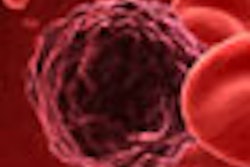
Clinical oral exams (COEs) have a poor overall performance as diagnostic methods for predicting dysplasia and oral squamous cell carcinoma (OSCC), according to a new study in the Journal of the American Dental Association (December 2012, Vol. 143:12, pp. 1332-1342).
When OSCC is detected in its early stages, the prognosis is better and the cost of care is lower, according to the study authors. However, some two-thirds of OSCCs are diagnosed at stage III or IV, indicating a need for improved detection and diagnostic methods.
A clinical oral exam -- which involves a head and neck examination, visual inspection of the oral mucosa under incandescent overhead or halogen illumination, and palpation -- is currently the most common technique used by dental practitioners to detect abnormal oral mucosal changes.
"Relying on a COE to detect oral dysplasia and OSCC, however, may be inadequate, as suggested by the finding that more than 30% of patients with OSCC and oropharyngeal cancer had undergone oral cancer screening during the three years before receiving a diagnosis of OSCC," the study authors wrote.
Comprehensive lit review
To evaluate the effectiveness of the clinical oral exam in predicting oral dysplasia or oral cancer, the researchers conducted a literature search on PubMed, Web of Knowledge, and the Cochrane Library of articles published from January 1966 through January 2010.
Using the search terms "oral mucosal lesion screening" and "oral lesions," they found 1,252 articles that met their criteria, but after excluding duplicates, case reports, expert opinions, animal studies, non-English studies, and articles that included data regarding only the detection of a particular lesion or did not include histologic diagnosis of oral mucosal lesions, they ended up with 24 observational studies that included 7,079 patients and 1,956 biopsies. These studies "reported histologic confirmation of clinically detected lesions identified by means of visual examination as subsets of data in studies assessing the COE and the use of adjunctive techniques," the researchers noted.
Because the 24 studies classified the patient's degrees of dysplasia in different ways, the study authors subgrouped the data into five categories:
- All types of dysplasia were considered as test-positive for potentially malignant epithelial lesions or OSCC.
- Mild dysplasia was considered as test-negative, and moderate and severe dysplasia as test-positive.
- Mild and moderate dysplasia were considered test-negative, but severe dysplasia as test-positive.
- All dysplasia was considered test-negative.
- Only a dichotomous evaluation (benign or malignant) was conducted.
The researchers then conducted a meta-analysis of the studies that considered all dysplasia as test-positive. They determined the quality (sensitivity, specificity, positive predictive value, negative predictive value, and diagnostic odds ratio [DOR]) of the studies using the Quality Assessment of Diagnostic Accuracy Studies tool.
Poor specificity
While the researchers found the sensitivity of the clinical oral exam to be good, it was not 100% because patients who had oral mucosal dysplasia or OSCC that had not been biopsied ultimately underwent histologic examination at some point. The researchers considered the lesions that were not biopsied initially but were found to have dysplasia or OSCC histologically to be false-negative, which lowered the sensitivity.
However, they found the specificity of the COE to be relatively poor, as were the positive and negative likelihood ratios (PLR and NLR). Given that the diagnostic odds ratio is PLR divided by NLR, the overall DOR was 6.1 (95% confidence interval), "which indicates the ineffectiveness of the COE to predict oral dysplasia or OSCC," the study authors wrote.
A COE alone may not detect the nature of an oral mucosal lesion accurately, "thus creating the potential for missed clinical lesions, which can affect the true outcomes of care," they added.
As a result, practitioners need to be vigilant when conducting head and neck and oral and oropharyngeal examinations, as well as during lymph node palpation, the researchers emphasized. "Considering that the dental office is the most common site for detecting oral cancer, proper education and training of dental professionals may assist in improving the sensitivity, specificity, and accuracy of oral cancer screening," they wrote.
Adjuncts continue to be sought to improve the findings and accuracy of the clinical oral exam, the researchers added.
"The fact that OSCCs often are diagnosed at an advanced stage emphasizes the need for improving the COE and the need to develop adjuncts to assist in oral mucosal lesion detection and diagnosis," they concluded.



















